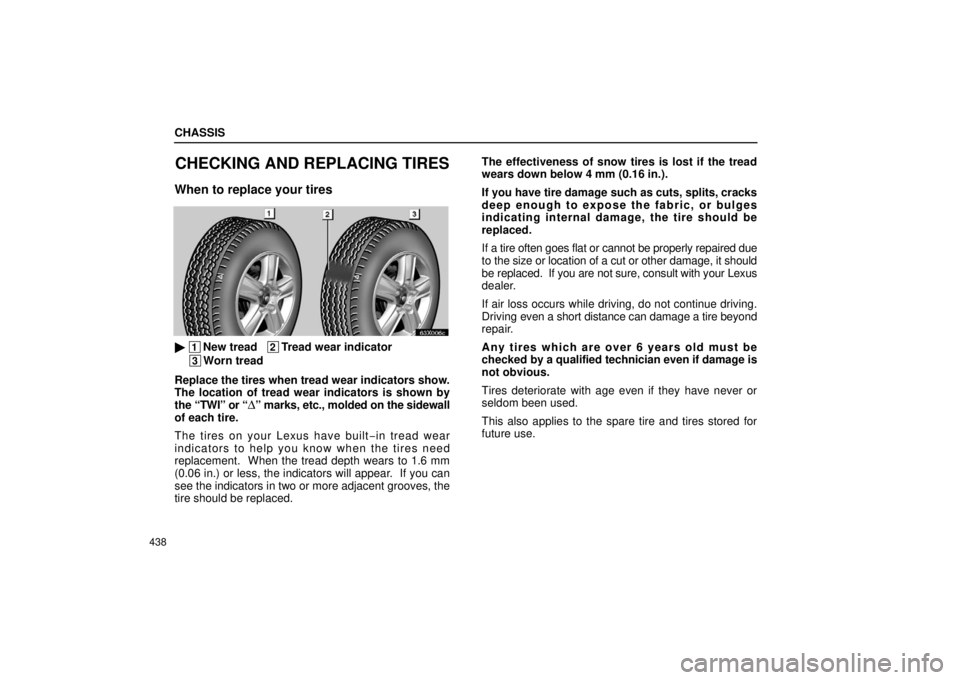Page 442 of 493
CHASSIS
420– STEERING
Free play
Less than 40 mm (1.6 in.)
Power steering fluidAutomatic transmission fluid DEXRON�II or III
– SUSPENSION
Fluid type
Suspension fluid AHC
– TIRES AND WHEELS
Tire sizeP275/60R18 111H
Tire inflation pressure
Recommended cold tire inflation pressure
Normal driving
Trailer towing
Front 200 kPa (2.0 kgf/cm2 or bar, 29 psi)
Rear 220 kPa (2.2 kgf/cm2 or bar, 32 psi)
Spare 220 kPa (2.2 kgf/cm2 or bar, 32 psi)
Front 220 kPa (2.2 kgf/cm
2 or bar, 32 psi)
Rear 240 kPa (2.4 kgf/cm2 or bar, 35 psi)
Spare 240 kPa (2.4 kgf/cm2 or bar, 35 psi)
Wheel size18 x 8J
Wheel nut torque131 N·m (13.4 kgf·m, 97 ft·lbf.)
NOTE:
For complete information on tires (e.g. replacing tires or replacing wh\
eels), see “Checking tire inflation pressure”
through “Aluminum wheel precautions” on page 424 through 443.
Page 447 of 493

CHASSIS
425
� Type B
The recommended cold tire inflation pressures, tire
size and the combined weight of occupants and
cargo (vehicle capacity weight) are described on the
tire and loading information label.
You should check the tire inflation pressure every two
weeks, or at least once a month. And do not forget the
spare! The pressure for the spare tire should be 220 kPa
(2.2 kgf/cm
2 or bar, 32 psi).
The following instructions for checking tire inflation
pressure should be observed:
� The inflation pressure should be checked only
when the tires are cold. If your vehicle has been
parked for at least 3 hours and has not been driven for
more than 1.5 km or 1 mile since, you will get an
accurate cold tire inflation pressure reading.
� Always use a tire pressure gauge. The appearance
of the tire can be misleading. Besides, tire inflation
pressures that are even just a few pounds off can
degrade ride and handling.
� Do not bleed or reduce tire inflation pressure after
driving.
It is normal for the tire inflation pressure to
be higher after driving.
� Never exceed the vehicle capacity weight.
Passengers and luggage weight should be located so
that the vehicle is balanced.
Page 460 of 493

CHASSIS
438
CHECKING AND REPLACING TIRES
When to replace your tires
63X006c
� 1New tread 2Tread wear indicator
3Worn tread
Replace the tires when tread wear indicators show.
The location of tread wear indicators is shown by
the “TWI” or “
Δ” marks, etc., molded on the sidewall
of each tire.
The tires on your Lexus have built −in tread wear
indicators to help you know when the tires need
replacement. When the tread depth wears to 1.6 mm
(0.06 in.) or less, the indicators will appear. If you can
see the indicators in two or more adjacent grooves, the
tire should be replaced. The effectiveness of snow tires is lost if the tread
wears down below 4 mm (0.16 in.).
If you have tire damage such as cuts, splits, cracks
deep enough to expose the fabric, or bulges
indicating internal damage, the tire should be
replaced.
If a tire often goes flat or cannot be properly repaired due
to the size or location of a cut or other damage, it should
be replaced. If you are not sure, consult with your Lexus
dealer.
If air loss occurs while driving, do not continue driving.
Driving
even a short distance can damage a tire beyond
repair.
Any tires which are over 6 years old must be
checked by a qualified technician even if damage is
not obvious.
Tires deteriorate with age even if they have never or
seldom been used.
This also applies to the spare tire and tires stored for
future use.